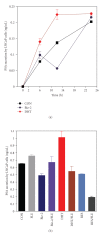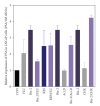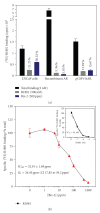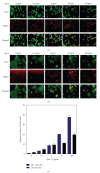Molecular and biochemical effects of a kola nut extract on androgen receptor-mediated pathways
- PMID: 20107586
- PMCID: PMC2811344
- DOI: 10.1155/2009/530279
Molecular and biochemical effects of a kola nut extract on androgen receptor-mediated pathways
Abstract
The low incidence of prostate cancer in Asians has been attributed to chemopreventative properties of certain chemicals found in their diet. This study characterized the androgenic and chemopreventative properties of the Jamaican bush tea "Bizzy," using androgen receptor positive and negative cell lines. Exposure of prostate cells to Biz-2 resulted in a growth inhibition (GI(50)) of 15 ppm in LNCaP cells and 3.6 ppm in DU145 cells. Biz-2 elicited a 2-fold increase in the mRNA of the anti-apoptotic gene Bcl2, with a 10-fold increase in that of the proapoptotic gene Bax. We observed a 2.4- to 7.5-fold change in apoptotic cells in both cell lines. Biz-2 at 10 ppm elicited a time- and dose-dependent stimulation of both the protein and mRNA levels of several androgen-regulated genes. Biz-2 caused a 36% decrease in PSA secretion and a significant increase in PSA mRNA. The relative binding affinity (IC(50)) of Biz-2 for AR was 2- to 5-fold lower than that of the synthetic androgen R1881. Biz-2 was found to be a specific ligand for the AR in that the natural ligand, DHT, and the anti-androgen, flutamide, displaced Biz-2 bound to AR and inhibited Biz-2-induced transcription and PSA secretion. This study provided evidence that Biz-2 extract possesses the ability to modulate prostate cancer cell biology in an AR-dependent manner.
Figures








Similar articles
-
Dutasteride, the dual 5alpha-reductase inhibitor, inhibits androgen action and promotes cell death in the LNCaP prostate cancer cell line.Prostate. 2004 Feb 1;58(2):130-44. doi: 10.1002/pros.10340. Prostate. 2004. PMID: 14716738
-
Two mutations identified in the androgen receptor of the new human prostate cancer cell line MDA PCa 2a.J Urol. 1999 Dec;162(6):2192-9. doi: 10.1016/S0022-5347(05)68158-X. J Urol. 1999. PMID: 10569618
-
Characterization of Bizzy Nut extracts in estrogen-responsive MCF-7 breast cancer cells.Toxicol Appl Pharmacol. 2007 Apr 1;220(1):25-32. doi: 10.1016/j.taap.2006.12.012. Epub 2006 Dec 21. Toxicol Appl Pharmacol. 2007. PMID: 17275869
-
p,p'-Dichlorodiphenyltrichloroethane (p,p'-DDT) and p,p'-dichlorodiphenyldichloroethylene (p,p'-DDE) repress prostate specific antigen levels in human prostate cancer cell lines.Chem Biol Interact. 2015 Mar 25;230:40-9. doi: 10.1016/j.cbi.2015.02.002. Epub 2015 Feb 12. Chem Biol Interact. 2015. PMID: 25682698
-
Anti-androgenic effect of astaxanthin in LNCaP cells is mediated through the aryl hydrocarbon-androgen receptors cross talk.J Food Biochem. 2021 Apr;45(4):e13702. doi: 10.1111/jfbc.13702. Epub 2021 Mar 10. J Food Biochem. 2021. PMID: 33694182
Cited by
-
Genetic variability of bioactive compounds and selection for nutraceutical quality in kola [Cola nitida (Vent) Schott. and Endl.].PLoS One. 2020 Dec 3;15(12):e0242972. doi: 10.1371/journal.pone.0242972. eCollection 2020. PLoS One. 2020. PMID: 33270707 Free PMC article.
-
Multifunctional titanium dioxide nanoparticles biofabricated via phytosynthetic route using extracts of Cola nitida: antimicrobial, dye degradation, antioxidant and anticoagulant activities.Heliyon. 2020 Aug 4;6(8):e04610. doi: 10.1016/j.heliyon.2020.e04610. eCollection 2020 Aug. Heliyon. 2020. PMID: 32775756 Free PMC article.
References
-
- Society, A. C. Cancer Fact and Figures 2007. American Cancer Society, 2007.
-
- Adlercreutz H. Western diet and Western diseases: some hormonal and biochemical mechanisms and associations. The Scandinavian Journal of Clinical & Laboratory Investigation. 1990;50(supplement 201):3–23. - PubMed
-
- Adlercreutz H, Markkanen H, Watanabe S. Plasma concentrations of phyto-oestrogens in Japanese men. The Lancet. 1993;342(8881):1209–1210. - PubMed
-
- Hedelin M, Klint Å, Chang ET, et al. Dietary phytoestrogen, serum enterolactone and risk of prostate cancer: the cancer prostate Sweden study. Cancer Causes & Control. 2006;17(2):169–180. - PubMed
-
- Knight DC, Eden JA. A review of the clinical effects of phytoestrogens. Obstetrics & Gynecology. 1996;87(5, part 2):897–904. - PubMed
Grants and funding
LinkOut - more resources
Full Text Sources
Other Literature Sources
Research Materials
Miscellaneous

